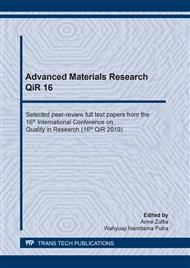p.278
p.285
p.293
p.303
p.311
p.318
p.324
p.331
p.339
Modified Activated Carbon Using NiO for Natural Gas Storage
Abstract:
The technology of natural gas adsorbed can be called Adsorbed Natural Gas (ANG) technology use porous adsorbents to adsorb natural gas. The material is activated carbon (AC), which has a large specific surface area. Activated carbon made from cassava peel waste because of abundance as agricultural waste in Indonesia. Cassava peel has a high cellulose and lignin content. Cassava peel through the carbonization process with furnace temperature 500 ° C in vacuum condition for 1.5 hours. Then, chemical activation with a different activator agent KOH and NaOH by mass ration (3:1). After that, physic activation with N2 and CO2 gas of 150 mL/minute using temperature muffle furnace 750 ° C. Product of physic activation modified using (Ni (NO3)2). Characterization of activated carbon performed with iodine test, SEM, EDX, adsorption, and desorption testers. The best of activated carbon is activated carbon impregnated KOH and with physic activation at 750 ° C, which has 612 mg / g of iodine number. Then, after activated carbon modified using (Ni (NO3)2) has the best performance with 1% NiO, has 662 mg / g of iodine number, and 657 m2 / g of SBET. Then, activated carbon through adsorption and desorption test by ANG technology has 0.02928 kg/kg of adsorption capacity and 39.17% of desorption percent.
Info:
Periodical:
Pages:
311-317
Citation:
Online since:
July 2020
Keywords:
Price:
Сopyright:
© 2020 Trans Tech Publications Ltd. All Rights Reserved
Share:
Citation:


